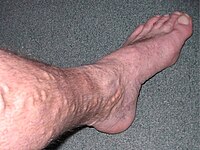Varicose Veins

Dominant inheritance with reduced penetrance was suggested by Arnoldi (1958). He thought that late menarche is related to varicosity. Varicose veins were about twice as frequent in females as in males and no male-to-male transmission was indicated in his illustrative pedigree. Possible X-linked dominance should be considered. Hauge and Gundersen (1969) presented a family study of 249 probands, with the conclusion that multifactorial inheritance seems 'very probable.' Matousek and Prerovsky (1974) used a multifactorial model and estimated heritability to be about 50%. Varicose veins are frequent in some genetic disorders such as the Marfan syndrome. Osler recognized the heritability of varicose veins: 'Varicose veins are the result of an improper selection of grandparents' (Aphorism 335 in Bean and Bean, 1950).
In a study of 2,060 female twin pairs aged 18 to 80 years who had responded to a self-administered questionnaire regarding varicose veins and hemorrhoids, Ng et al. (2005) found that casewise concordance rates were significantly higher for monozygotic than dizygotic twins for both phenotypes, corresponding to additive genetic heritabilities in liability of 86% for varicose veins and 56 to 61% for hemorrhoids. Varicose veins and hemorrhoids were significantly correlated. In 900 dizygotic female twin pairs, significant linkage for varicose veins was found at marker D16S520, located about 80 kb from FOXC2 (602402), but no association was found. Both linkage and association tests were negative for hemorrhoids and for the combined phenotype of varicose veins and hemorrhoids. Ng et al. (2005) concluded that varicose veins and hemorrhoids are heritable, related conditions, and suggested that FOXC2 is implicated in the development of varicose veins in the general population.